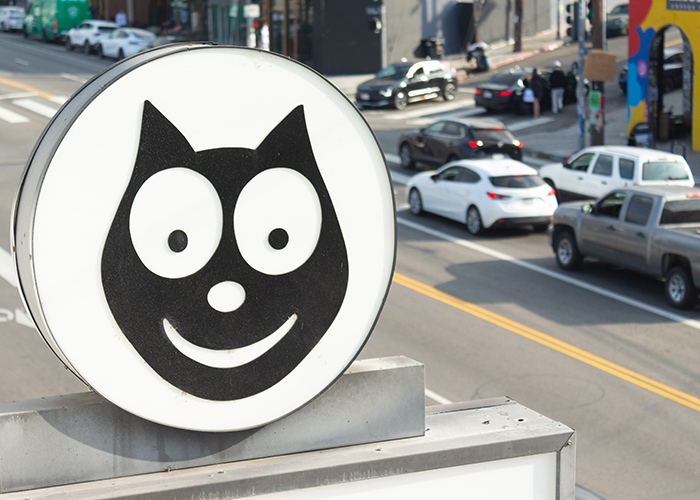 Last Restoration |
Los Angeles, CA |  More 2023 Adventures |
California has a new historical landmark, everyone!
Way back on December 7, 2017, I was riding high on my first historical landmark plaque dedication: the Richmond Shipyards District. It was a small event with a few of my landmarking friends, so small that it bamboozled the East Bay Times, but I felt pretty darn good about it. As my friend, Jay Correia from the California Office of Historic Preservation (OHP) put it:
[A]fter ten years you are the only individual who has followed through with casting and installing a California Historical Landmark plaque. Organizations get it done about once every year, but no individual. Despite at least one contact per month and often as many as four contacts per month.
So naturally, that got me thinking about other landmarks to restore, even brand new ones to nominate! After a visit to the Silver Lake neighborhood in my home city of Los Angeles, I had just the place: the Black Cat Tavern, site of California’s first gay rights protest and eligible, as of February 11, 2017, to become California’s newest historical landmark!
Part 1: Getting Purr-mission
After spending six years questing for California’s more than 1,100 historical landmarks, not one had mentioned LGBTQ+ History! So I wrote Mr. Correia back for more information on how to nominate the Black Cat. After all, it met the criteria of “first, last, only, or most significant historical property of its type in the region,” so this felt like a sure bet! Mr. Correia wrote back:
Regarding nominating new Landmarks, the only inclusive packet would be the webpages devoted to CHLs. All California designations (California Register, California Historical Landmarks, California Points of Historical Interest) use the DPR 523 form. […] If you are going to take on writing, just remember that we are pretty tough editors.
There was an additional catch: it’s almost harder to nominate for the state registry than the National Register of Historic Places! That’s because California requires written permission from a property owner before a site can even be nominated. So the hunt began! Drawing from what I learned in Richmond, I contacted the LA County Assessor’s Office to find out who owned the property, and on March 6, 2018, I mailed my first letter to ROCO Investment Holdings, LLC along with ideas for where a plaque could go!
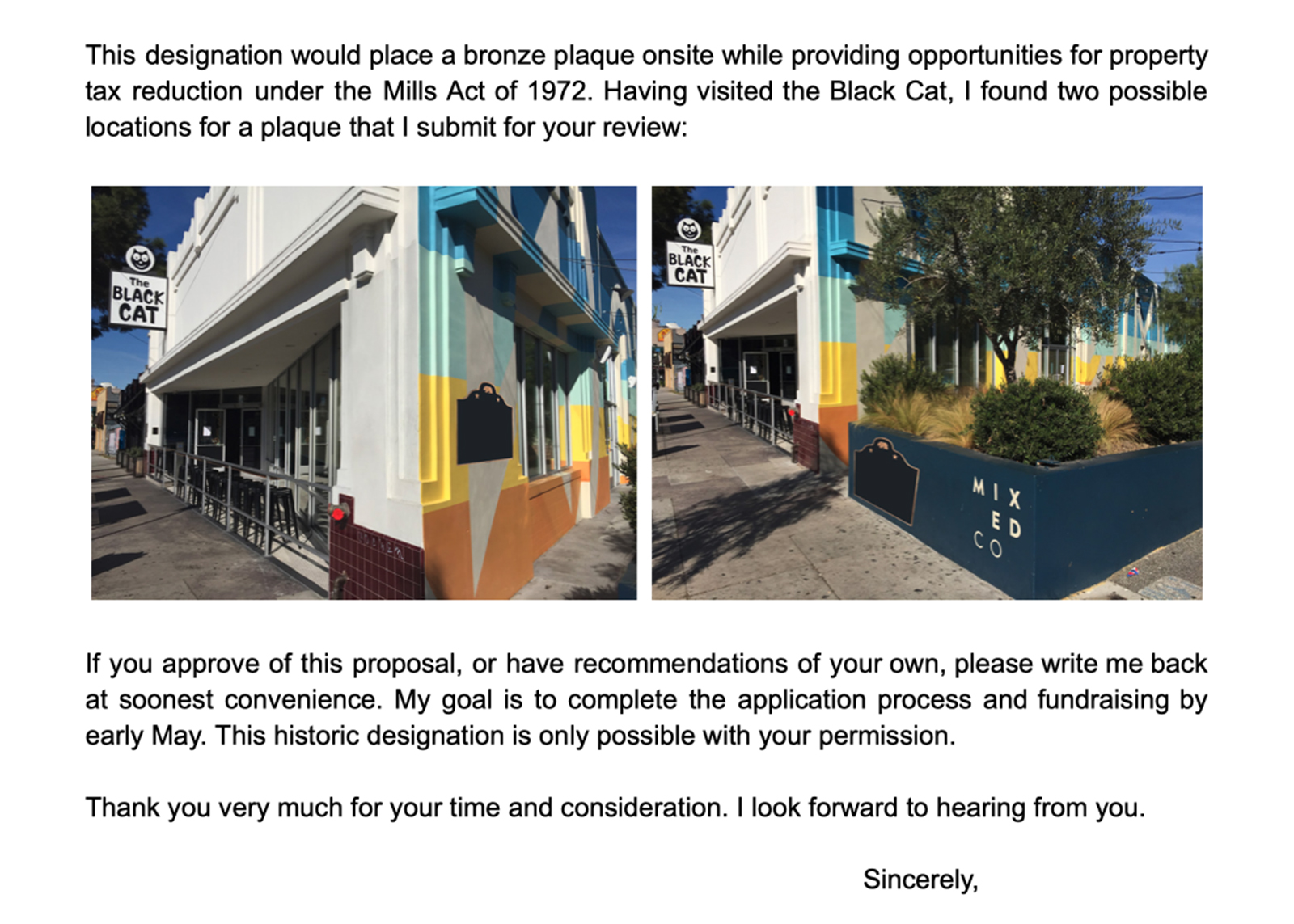 |
I didn’t hear back. The Assessor’s office only had an address, no phone number or email, so I went looking for someone else to help make the connection. Between April 10, 2018 and August 12, 2019, I visited the Black Cat a couple of times but made no progress on getting permission. Meanwhile, I was also working on replacing old, missing plaques, like the S.S. Catalina (#894) and the Sikh Temple Site (#1039), but I couldn’t get a yes or no from those organizations either! Plus, the folks at the Gurdwara Sahib only spoke Punjabi!
I looked up the Friends of the Black Cat, who led the push to make this a Los Angeles Historic-Cultural Monument back in 2008, the year Proposition 8 made gay marriage illegal in California, but I couldn’t find them anywhere online! On October 12, I went sleuthing at the Archives Bazaar at USC, where a representative of ONE Archives, the world’s largest repository of LGBTQ+ historical materials, directed me to the LA Conservancy instead, with this caveat:
The person who used to be their LGBT project person is no longer there, but I recommend contacting them and finding out what resources or guidance they can give.
The LA Conservancy had no leads for me to chase, so I sat down on a cold trail all through a global pandemic. It was a rough year, but 2021 brought some hope, and with that, I sent another letter to ROCO Investment Holdings LLC on January 9, 2021. Still no reply! I went back to the Black Cat, where the unit next door was “For Lease” and reached out to the realtors. Crickets! I reached out to the City Council Office for District 13, where I connected with Lambert Giessinger, supervisor of LA’s version of the OHP. He had an email address for me! I sent my first email to the Black Cat owners on May 20th and got… no response! By June 3rd, Mr. Giessinger said:
I would suggest proceeding with a National Register nomination.
It wasn’t going to happen. Either folks weren’t keen on having a plaque on their property, or it was just too unusual to get contacted by an over-eager beaver. I was ready to throw in the towel when my friend, Ray Najera from the California Landmark Foundation, offered to try it himself. On July 13, 2021, he wrote me back with some astonishing news:
I have obtained written permission from the owner of The Black Cat to nominate it as a California Historical Landmark.
Part 2: Playing Cat-chup
After four years of ice cold trails, was I about to get miffed that Ray got an immediate, enthusiastic response? Absolutely not! With permission granted, there was loads to do! The State Historical Resources Committee, who reviews new landmark nominations, had scheduled their next quarterly meeting for October 29th. And I completely missed it!
A lot goes into a landmark nomination packet, from assembling street maps to historic photos of the site, to giving reviewers an airtight argument for why they should consider the site important to California history. I lucked out because I got to stand on some gigantic shoulders! Wes Joe and Charles Fisher had done a fantastic job with their Historic-Cultural Monument application, especially their in-depth description of the architecture! Plus, the National Park Service had done a comprehensive theme study of LGBTQ America!
All in all, it took a review of 20 different websites, articles, and podcasts to complete the application, learning tons about California penal code and Los Angeles’ historic gay cruising spots. I parsed words with State Historian, William Burg, over the meaning of “first” and “protest,” learned lots about other events vying for those titles, and at last, submitted the application on November 4, 2021 to be reviewed at their next meeting!
With the application assembled, I could sit back and pass the holidays planning adventures again, but I couldn’t wait to tune in to the live Zoom meeting on January 21, 2022 (1:02:28 on the recording) to hear the results! After a few minutes recapping the juiciest tidbits about the Black Cat, Mr. Burg announced:
Staff supports the nomination as written and recommends the State Historical Resources Commission determine the Black Cat Tavern meets the requirements for listing as a California Historical Landmark as the first, last, or only of its type in Southern California, as the site of Southern California’s first public gay rights protest, and its role in LGBT history.
Part 3: Curiosity Builds a Plaque
At this point, the pageantry and public comments were done, but not the work! It took the OHP six months to finalize the paperwork that officially made the Black Cat Tavern California’s 1063rd historical landmark. Then it took another six months to compose, review, argue, revise, and finalize what would go on the plaque itself (which, as a first-time plaque and not a replacement, had to be bronze, not aluminum)!
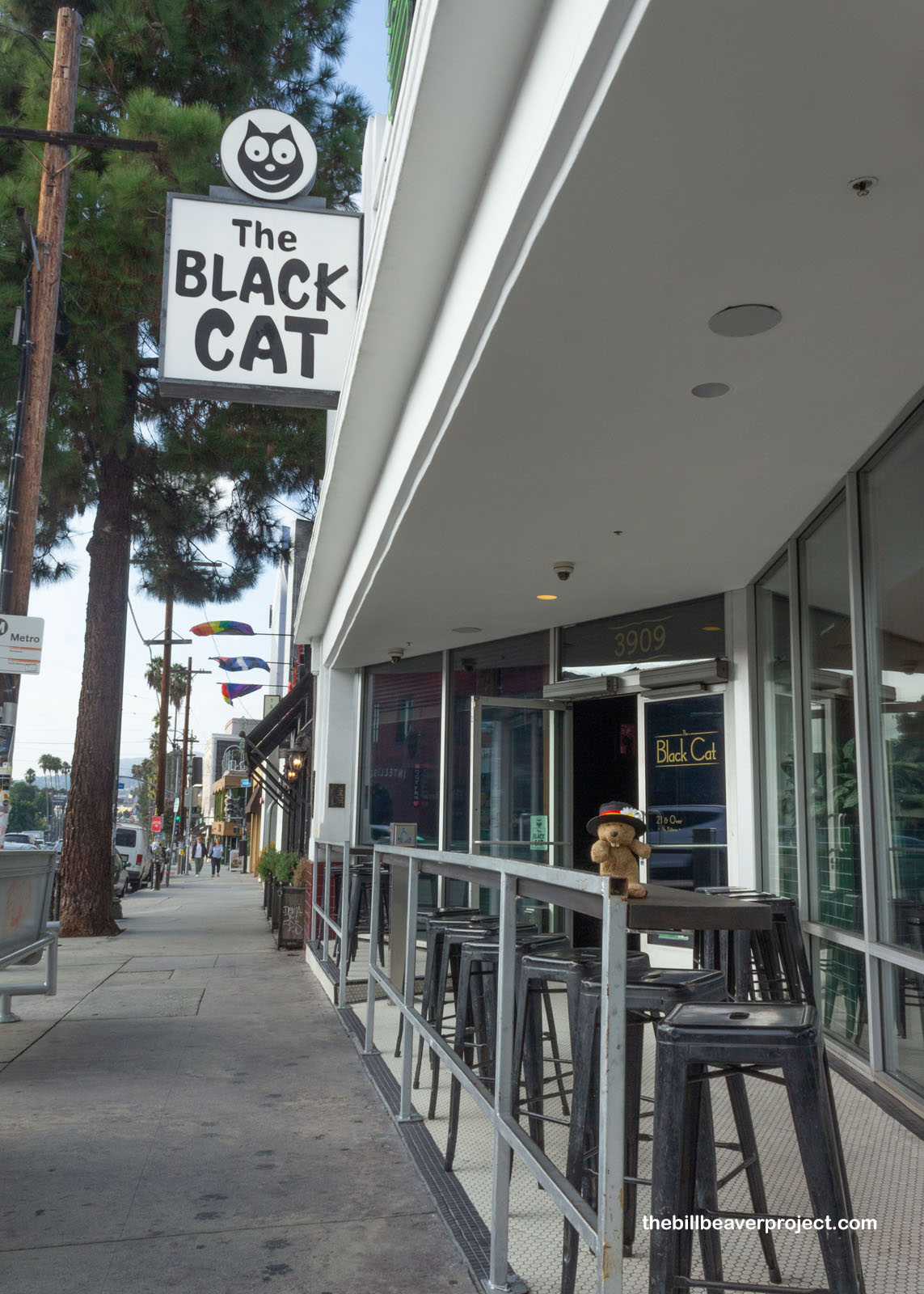 |
During this time, I came to accept this as a Southern California first, not a California first. Why? Back in 1967, there was no such thing as “LGBT History,” so up until 1988 or so, the gay rights protest at the Black Cat wasn’t considered the same basic area of history as the trans rights protest at Compton’s Cafeteria in San Francisco on July 19, 1966. Today, they share a timeline and a chronology, but I’ll save Compton’s Cafeteria for later. Anyway, after lots of back and forth, Messrs. Burg and Correia signed off on the plaque text, and I sent it off to plaquing favorite, John Kolstad at California Bell Co., on January 9, 2023!
I would be honored to make your plaque. I grew up in that era. Once you order we always provide an initial proof before casting where you can still make minor changes to text and layout. Once you formally sign off on your proof we start production which usually takes 35 days plus 5 days shipping for you to receive it.
Oh no! With that kind of turnaround, it wasn’t too likely that we’d be installing a plaque on the anniversary of the Black Cat protest (February 11)! From there, two things set back the schedule even further: what date would be a good alternative and who would foot the $4,400.67 bill for bronze! David Cohen, the owner of the Black Cat, who turned out to be a really swell guy, had hinted that he might, but neither Ray nor I knew how to press him for a definite answer. So this beaver ended up footing the bill and settled on Saturday, June 3rd, the first weekend of Pride Month, to install it. On May 5th, the plaque arrived at my door!
Once I had the plaque, my whole approach changed. I emailed the Black Cat again with certainty—”California to recognize The Black Cat as first LGBT landmark”—and right away, I got to meet with manager, Masha, to figure out where to hang the plaque. I’d been in touch with DiBara Masonry, an LA Conservancy recommendation, about installing a base outside, but it was going to be super expensive.
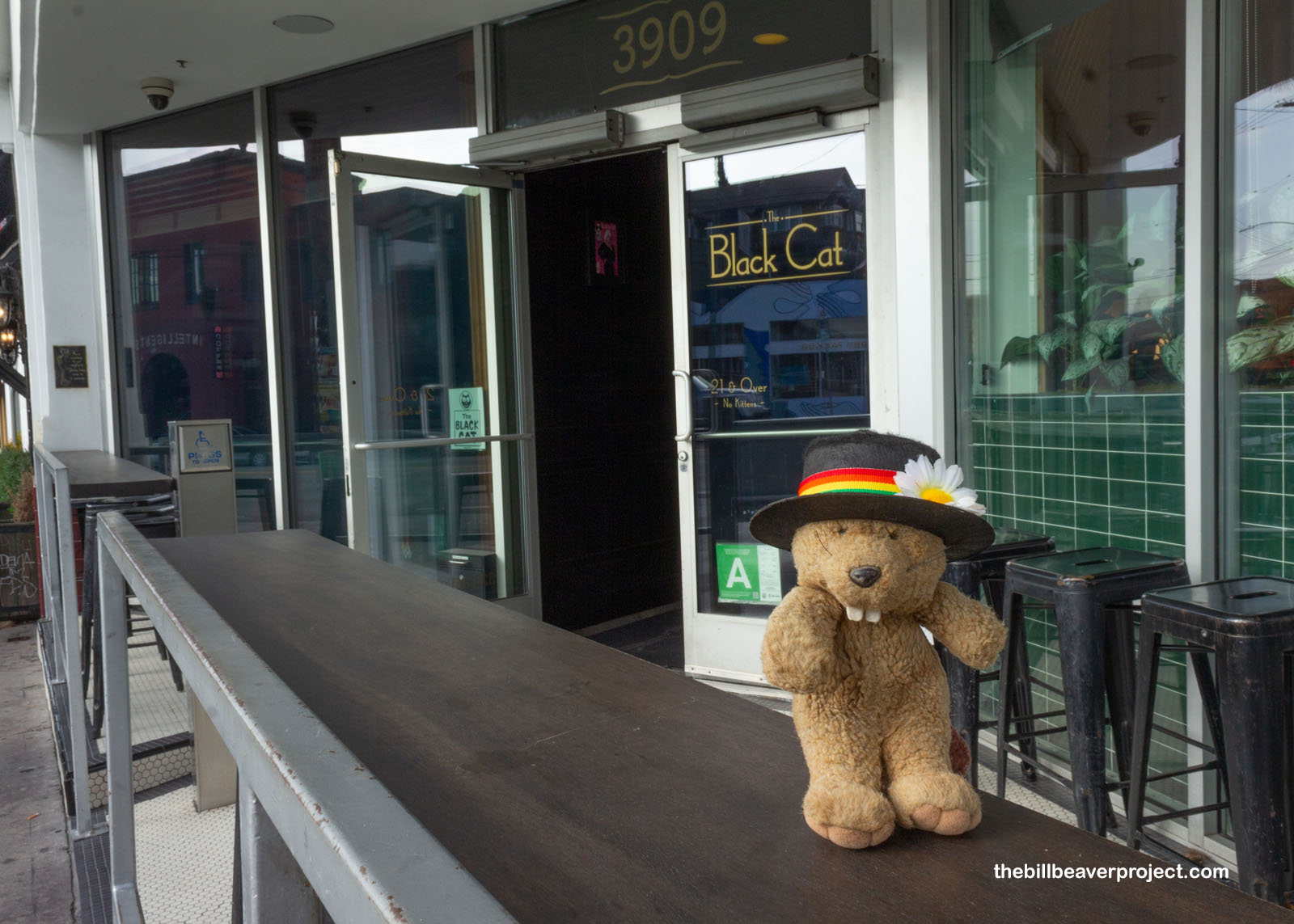 |
Masha pointed to a big empty space on the wall just inside the entrance and suggested, “What about there?” Mr. Cohen gave it the all-clear. This was going to be much easier than expected! That feeling lasted 24 hours, when I got an email from Charlie at the Black Cat.
We really appreciate the time and energy you have put into The Black Cat’s Historical recognition. Unfortunately, some of this information is historically inaccurate.
The first paragraph is quite confusing: […] It reads as if the protest took place on New Year’s Eve (Should be possessive Year’s) instead of the LAPD raiding The Black Cat on New Year’s Eve.
I couldn’t believe it. The plaque had been approved by multiple state historians. There’s no way it could be inaccurate—yup, yup, it did read that way. Well crap! Not only was the plaque confusing, but the spot inside the door wasn’t working. The Black Cat of today is a 21+ establishment, and keeping it behind a door would cut off the history to families and anyone visiting outside normal business hours! It would have to be re-cast (upward of $4,000) and mounted on a base (between $3-5,000 more)! I sure wasn’t going to afford that, and what about the Pride Month dedication, and what about the humongous bronze plaque now sitting in my living room?!
Part 4: The Nine Lives of a Landmark
A bunch of really sheepish emails followed to Messrs. Kolstad, Correia, and Burg as Part 3 of this saga restarted as Part 4. It’s a good thing a cat has nine lives! The difference this time was that the team at the Black Cat was fully on board, especially Charlie, Dean, and Lindsay, who came in with revisions, ideas on where to display the plaque, and most importantly of all, an offer to fund both the second plaque and the base!
With new verbiage approved and a new order submitted to California Bell, we decided the next best day would be Sunday, October 1, the first day of LGBT History Month! Some arguments followed among all parties, but Mr. Kolstad offered to buy back the old plaque while sending the new one directly to the Black Cat. The revised plaque arrived on August 17th, and we all had our first onsite meeting to finalize where it would go and how we’d hold the ceremony. Ray would handle the press releases, Michael (CLF) would bring the equipment, and Lindsay & I would plan out the event itself. By September 13th, DiBara Masonry had installed the plaque at the corner of Sunset and Hyperion and given it a nice cover to keep it safe until Dedication Day! All that was left was to promote the event…
|
|
|
This event was going to be unlike any we’d ever put on before. We were no longer out in rural Tracy or Blythe with a potential attendance under 20; this was right in the heart of Los Angeles with a social media campaign, RSVPs from dignitaries, and maybe even one of the original witnesses to the Black Cat protest!
 |
There were also folks who took offense to anything “LGBTQ+” and made their distaste very much known on social media. It was something I kind of expected. After all, this past June, vandals defaced two lifeguard towers on “Ginger Rogers” Beach only two days after they were painted the colors of the Progress Pride flag. I wasn’t too worried about trolls, but it was something else to consider that we’d never encountered before. On top of all of that, the forecast for Sunday, October 1st was rain!
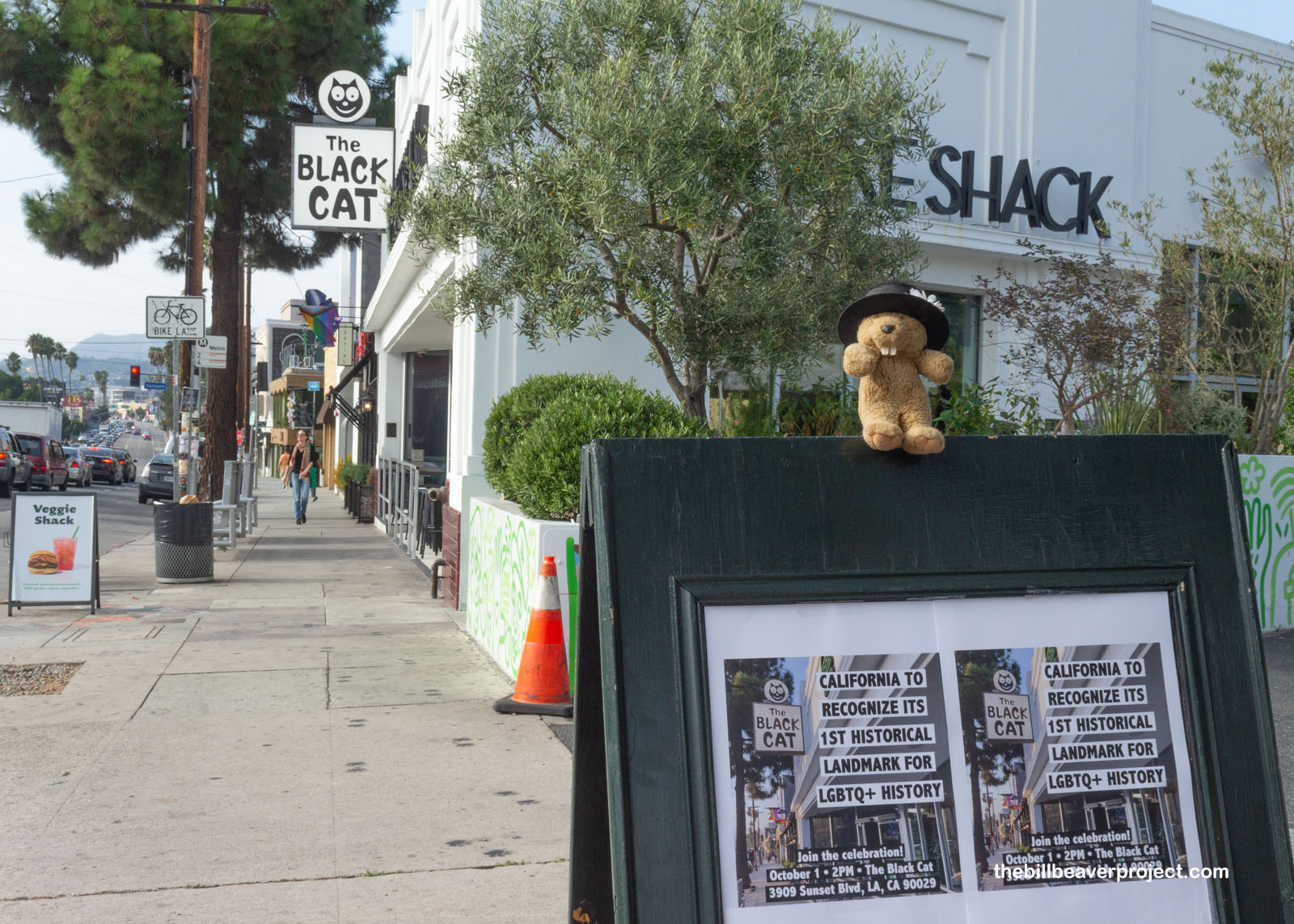 |
I barely slept that night! I was so nervous and excited, and nervous again, especially when the car wouldn’t start and it was full of audio equipment! That took a quick fix of the beeper battery, and I was off again. Ray and his wife, Tang, had gotten there ahead of me to set up, and Lindsay introduced me to Daniel Henning, who had organized a reenactment of the protest on its 50th anniversary, February 11, 2017! The speaking lineup had expanded, but we were going to make it work. In an 11th hour surprise, Alexei Romanoff, who was there the night of the protest, would be there and might even speak!
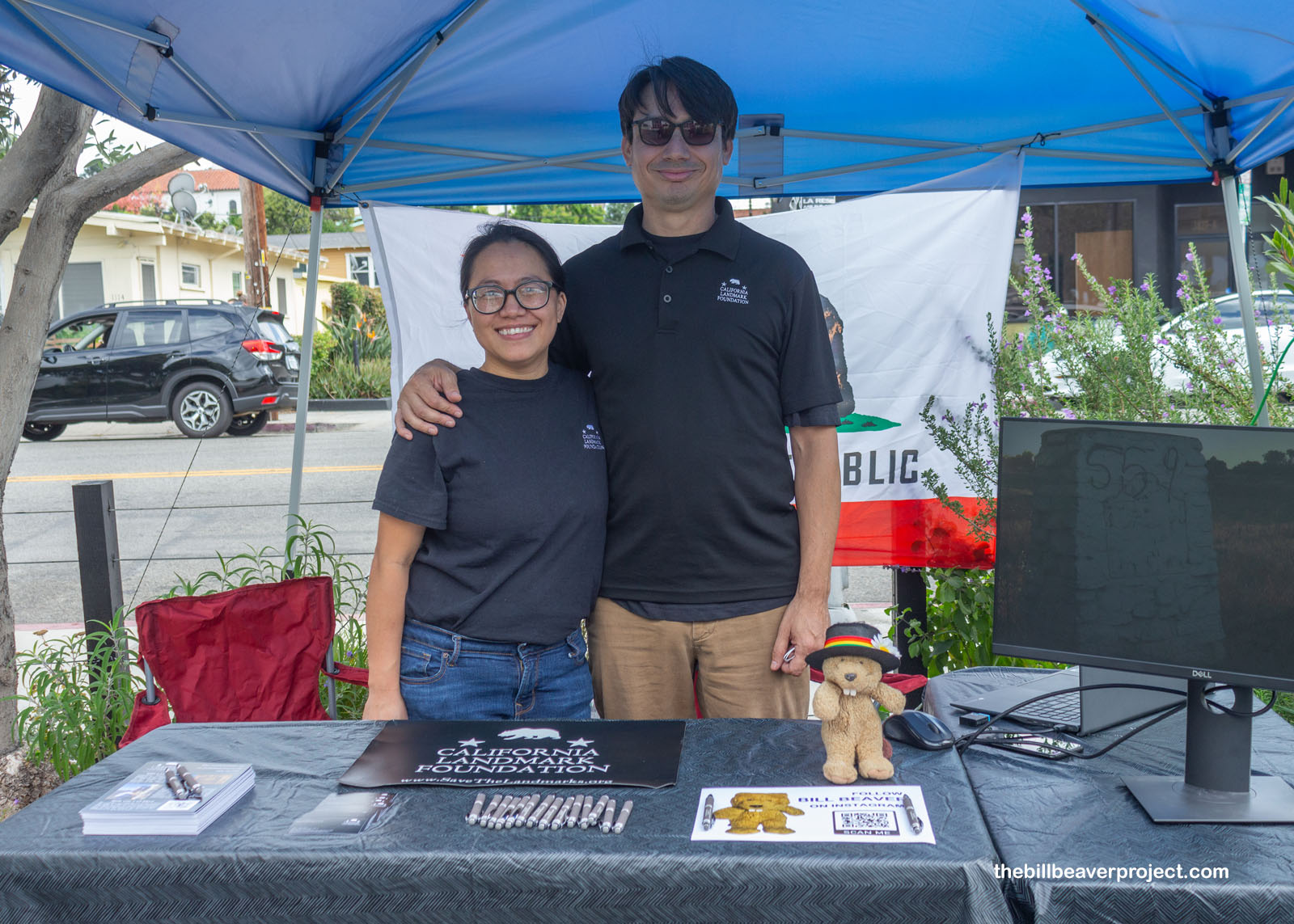 |
And then folks started showing up: politicians, news crews, and local folks who wanted to know what the hubbub was about! Lindsay kicked us off at 2:15 PM with an intro, then I got to talk about the landmark program as a whole! Then Assemblywoman Wendy Carrillo presented a certificate of appreciation to the Black Cat, and Assemblywoman, Lauren Friedman, gave a passionate speech about the violent reactions to Pride Month at her daughter’s school in Glendale! City Councilman, Hugo Soto-Martinez spoke, followed by Mr. Romanoff himself, and then Mr. Henning closed us out, calling everyone to be witnesses to this moment. And then that big moment arrived!
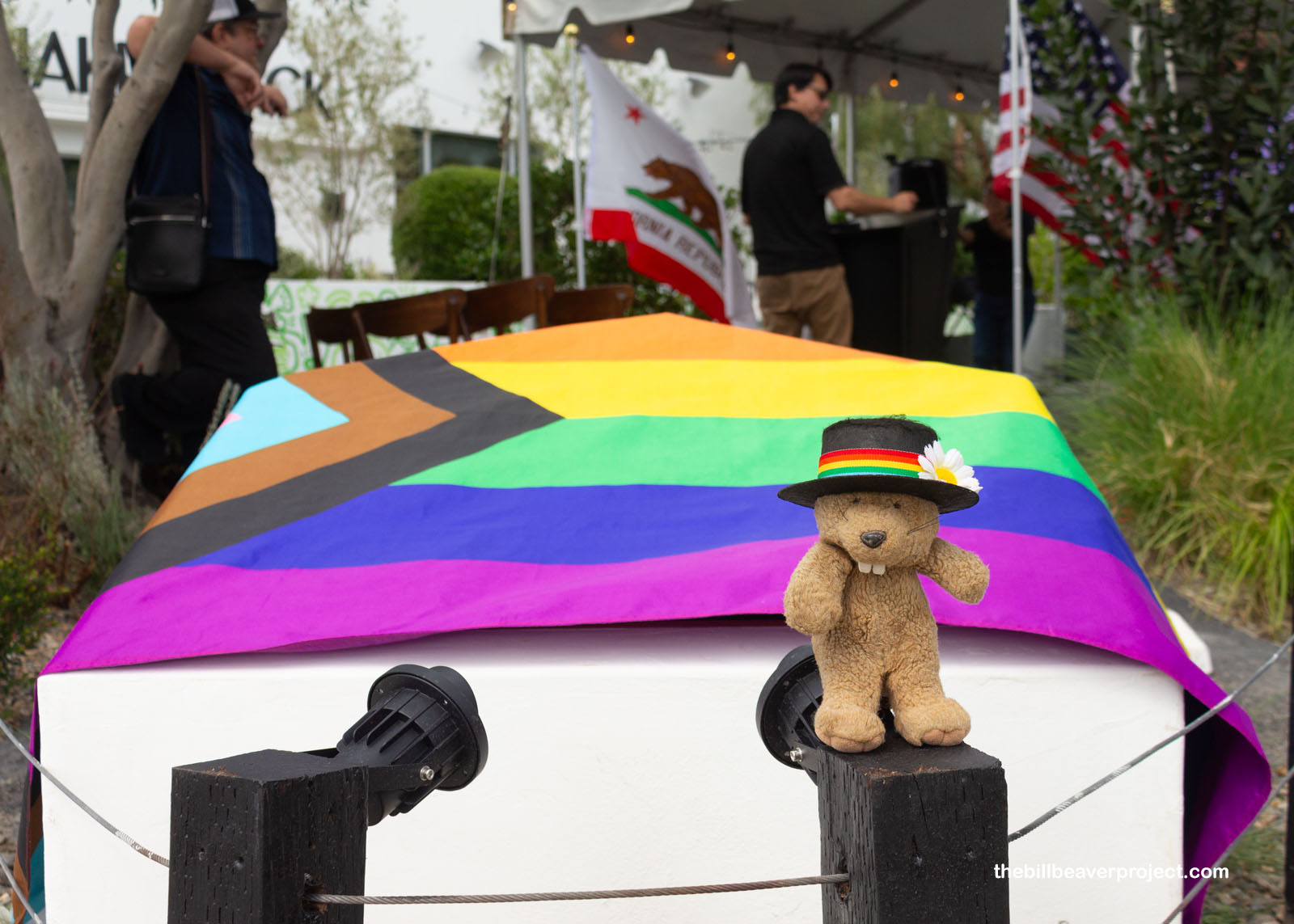 |
With cameras clicking, Mr. Romanoff drew the Progress Pride flag off the fully mounted, positively glowing Black Cat Tavern plaque, and boy was it something! Folks were passing by and marveling that a local haunt had been recognized for state-level importance! My friend, Donald Laird, arguably the pioneer of landmark hunting in California, triumphantly touched the newly dedicated plaque, his persnickety criteria for counting it as visited! I still got called a bear a few times, but I got to set the record straight on camera. Oh my gosh, I’d never been on the news before!
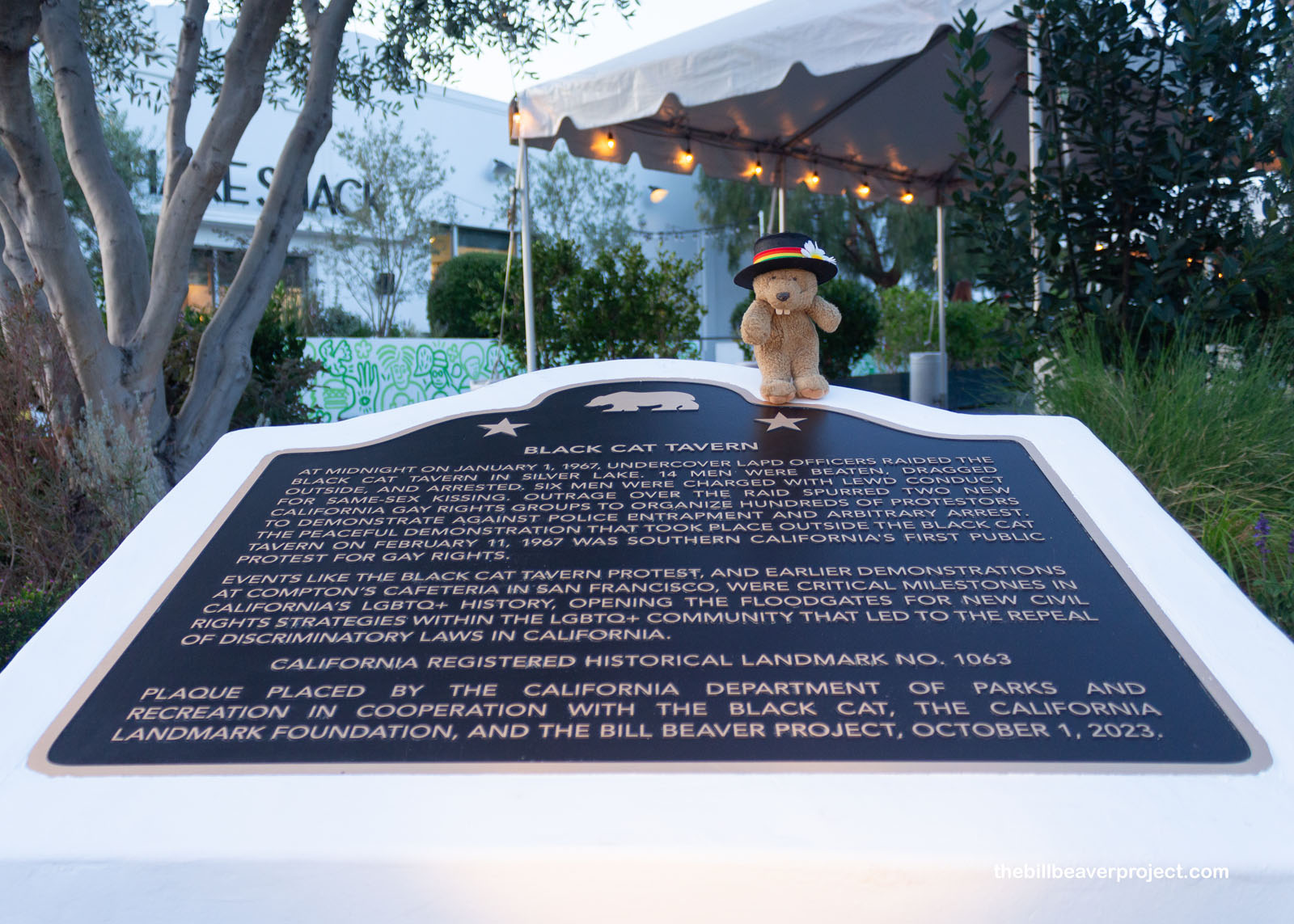 |
And then, it was over! I got star-struck answering questions from the Los Angeles Times, and then it was all celebratory crème brûlée until sunset brought up the spotlights on the plaque. This might be California’s only historical landmark plaque with spotlights! But beyond that, folks left that event buzzing about what else they could do to tell the stories of LGBTQ+ folks here in California. There were whispers that folks from Cooper’s Do-nuts, site of a 1950s riot, were there, and more whispers about naming this Alexei Romanoff Square or add another rainbow crosswalk. These were just whispers, but they could lead to lots more landmarks to track down. You know what, though? That’s okay! The more stories out there, the better, and I love getting opportunities for adventure!
So what’s next? I might help Donald in his pursuit of nominating Charles Schultz’s house, or I might take a break from new plaques and see what the California Landmark Foundation has on their agenda next. But once that break’s over, you can bet I’m coming for Compton’s Cafeteria up in San Francisco! Look out, OHP, this beaver’s building the register!
Be good, all you cool cats and kittens!

 Last Restoration |
 More 2023 Adventures |
